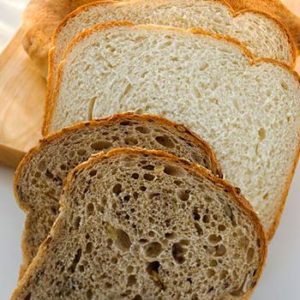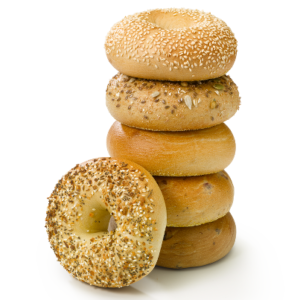20 Apr White vs. Wheat: Is There Really A Difference?
Don’t you hear this all of the time? “You should eat whole wheat stuff instead of white stuff.” Sure, I get it. Whole wheat has been pushed as the “healthier” version of the bread, rice (brown), etc… but how much healthier is it? Lets take a closer look.
To answer the question: YES. A whole-wheat version of anything is much healthier than a white version of anything (talking bread, rice, flour, etc.). Whole wheat bread will provide more essential nutrients than white bread, simply because it is not refined and still has the bran and germ in tact, which the white bread does not. Whole-wheat versions will have much more fiber than white, and we all know the benefits of fiber, right? Fiber helps blunt the glycemic response, improves the health of your gut and intestinal lining, keeps you fuller for a longer period of time, reduces constipation, and can also decrease your risk of digestive system issues, diverticulosis, colon cancer, myocardial infarction, and obesity.
Since white bread, white rice, etc. are all stripped of the bran and germ during processing, they lose a ton of nutrients.  Whole wheat is much higher in the B vitamins, magnesium, zinc, folic acid, and chromium. But then you ask, “Aren’t white versions fortified with those nutrients? So can’t I just keep eating white, while still getting those benefits?” First part of your question: correct. Second part of your question: not really. You see, when white flour for rice or bread is processed and refined, nearly 30 or more nutrients are removed; and by law, only 5 of those 30 have to be replaced. You may be getting some back with the fortified version, but nowhere near the amount you’d be consuming if you ate whole wheat.
Whole wheat is much higher in the B vitamins, magnesium, zinc, folic acid, and chromium. But then you ask, “Aren’t white versions fortified with those nutrients? So can’t I just keep eating white, while still getting those benefits?” First part of your question: correct. Second part of your question: not really. You see, when white flour for rice or bread is processed and refined, nearly 30 or more nutrients are removed; and by law, only 5 of those 30 have to be replaced. You may be getting some back with the fortified version, but nowhere near the amount you’d be consuming if you ate whole wheat.
Here is where you may be surprised: the glycemic index. The glycemic index refers to a food’s ability to raise insulin levels once it is eaten. The food will be ranked on a scale from 1 to 100 and usually, the food with the lower glycemic index value would be healthier. The lower a food’s glycemic index, the less it will affect your blood sugar and insulin levels. It also must be noted that the glycemic index only measures that food when it is eaten all by itself. For example, white rice has a glycemic index of 89, when it is eaten all by itself… once you add some complete protein and healthy fats to that white rice to make a balanced meal, that glycemic index number basically means nothing. It gets completely washed out, since protein and fat slow the rate of digestion for just about everything.
When researchers measured and compared the glycemic index of white bread to wheat bread, they found that there was no  significant difference between the two. The glycemic index for whole wheat bread is 71 (+ or – a few). The glycemic index for a white bagel is 72. What?! That can’t be. Wheat bread is supposed to be so much healthier for me! I could’ve had white bagels all this time?! Well, whole wheat bread is still healthier, if we’re talking about the fiber and vitamins it contains, but if we’re talking about how it spikes insulin and affects blood sugar levels, it’s not much healthier than white bread; bad news for diabetics and glucose-intolerant individuals who eat wheat bread in hopes of consuming a “healthier” option.
significant difference between the two. The glycemic index for whole wheat bread is 71 (+ or – a few). The glycemic index for a white bagel is 72. What?! That can’t be. Wheat bread is supposed to be so much healthier for me! I could’ve had white bagels all this time?! Well, whole wheat bread is still healthier, if we’re talking about the fiber and vitamins it contains, but if we’re talking about how it spikes insulin and affects blood sugar levels, it’s not much healthier than white bread; bad news for diabetics and glucose-intolerant individuals who eat wheat bread in hopes of consuming a “healthier” option.
I’ll tell you this from my personal perspective: I eat white rice everyday. However, I also eat sweet potatoes, a ton of vegetables, and fruit everyday as well. I can’t stand the taste of brown rice. If I had to eat it, I wouldn’t enjoy it one bit; and that is a recipe for disaster. For your weight loss and health to be sustainable and a long-term success, you have to enjoy what you’re eating. As long as I’m getting an abundance of fiber (35+ grams per day), vitamins, minerals, and anti-inflammatory agents everyday from my “healthy” foods (sweet potatoes, berries, avocados, vegetables, etc.), then I allow myself to have some white rice, even though it really isn’t adding any nutritional value to my program. The carbs are still going to be digested into glucose and used for energy during my workouts, the same way the carbs from brown rice would be used.
All in all, I don’t believe you need to choose whole wheat or brown versions of EVERYTHING you eat. There’s a reason white rice, white bread, white pasta, etc. are sold way more than the wheat versions, and that’s because they taste better. However, you shouldn’t ONLY be eating white versions of everything either. Get your vegetables in at every meal. Include healthy fats at certain times of the day. Include some fruit at your breakfast or before your workout. Find some other ways to get in all of those micronutrients you need, while still satisfying that “white bread” portion of your palate. 🙂
Paul A. Hovan Jr., B.S., NASM CPT, CSN, CSCT
References:
http://www.trimdownclub.com/is-whole-wheat-bread-actually-healthier-than-white-bread/
http://www.livestrong.com/article/289338-whole-grain-bread-vs-white-bread/
http://www.vegetariantimes.com/article/white-bread-vs-wheat-bread/
http://www.health.harvard.edu/healthy-eating/glycemic_index_and_glycemic_load_for_100_foods



No Comments